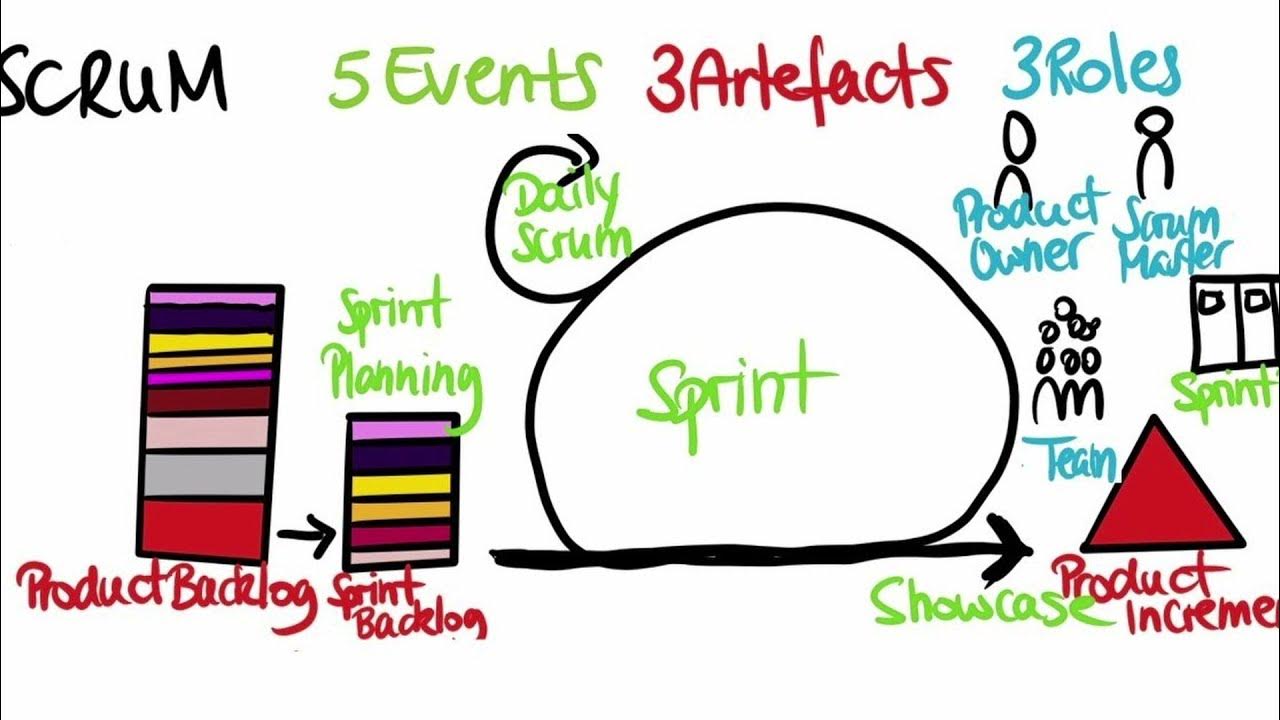What is Scrum?
Summary
TLDRScrum is an agile framework that helps teams manage complex projects by organizing work effectively and adapting to changes. The process begins with the product owner creating a prioritized backlog, from which the team selects tasks during Sprint planning. With a set time frame, the team works to complete the tasks and holds daily scrums to maintain progress. At the end of each Sprint, the team reviews the product and process, making adjustments as needed. Scrum ensures the most valuable work is completed and provides a continuous cycle for improvement and delivery.
Takeaways
- 😀 Scrum is an agile framework designed to help manage complex projects and avoid common challenges such as scope changes and unclear roles.
- 😀 A product owner creates a prioritized product backlog, which is essentially a wish list of features or tasks.
- 😀 During Sprint planning, the team selects items from the backlog and determines how to complete them within the Sprint timeframe.
- 😀 The team works in a set time frame, called a Sprint, to complete their chosen tasks.
- 😀 Daily Scrum meetings help the team stay focused and ensure the work progresses smoothly.
- 😀 The Scrum Master plays a key role in keeping the team on track and helping them remain focused on their goals.
- 😀 At the end of each Sprint, the work should be potentially shippable, meaning it is ready for release if necessary.
- 😀 A Sprint Review is held to evaluate the product, and a retrospective is conducted to assess the process and make improvements.
- 😀 After completing a Sprint, the team selects the next set of tasks from the product backlog for the following Sprint.
- 😀 Scrum helps ensure that the most valuable work is completed by the end of the project, keeping it focused on delivering high-priority features.
Q & A
What is Scrum, and how does it help in managing complex projects?
-Scrum is an agile framework designed to manage complex projects. It helps by organizing team roles, defining clear scopes, and breaking down tasks into manageable pieces. It provides structure through sprints, daily scrums, and retrospectives, which helps ensure work progresses smoothly and efficiently.
Who is responsible for creating the product backlog in Scrum?
-The product owner is responsible for creating the product backlog in Scrum. This backlog is a prioritized list of tasks or features that need to be developed.
What happens during Sprint planning in Scrum?
-During Sprint planning, the team selects a chunk of work from the top of the product backlog and determines how to complete it within the set time frame of the Sprint.
How long is a typical Sprint in Scrum?
-The length of a Sprint in Scrum is typically fixed, often lasting two to four weeks, and is designed to be long enough to complete meaningful work but short enough to maintain focus and adaptability.
What is the role of the Scrum Master?
-The Scrum Master is responsible for keeping the team focused and removing obstacles that might hinder progress. They ensure that Scrum practices are followed and that the team remains productive.
What is the purpose of the daily scrum in Scrum?
-The purpose of the daily scrum is to provide a quick, regular check-in where team members discuss what they've done, what they plan to do, and any obstacles they are facing. This helps keep the work moving forward.
What happens at the end of a Sprint in Scrum?
-At the end of a Sprint, the team conducts two key activities: a Sprint review, where they assess the completed work, and a retrospective, where they reflect on the process to identify areas of improvement.
What is meant by 'potentially shippable' work in Scrum?
-Potentially shippable work means that at the end of the Sprint, the team should have completed a portion of the product that is ready to be released or deployed, ensuring that each increment of work adds value.
How does Scrum ensure that the most valuable work is completed first?
-Scrum ensures the most valuable work is completed first by prioritizing the product backlog. The product owner sets priorities based on business value, ensuring that the team works on the highest priority tasks during each Sprint.
What happens after a Sprint retrospective in Scrum?
-After a Sprint retrospective, the team identifies areas of improvement for the next Sprint. They then choose the next chunk of work from the product backlog and repeat the cycle, ensuring continuous improvement and adaptation.
Outlines

此内容仅限付费用户访问。 请升级后访问。
立即升级Mindmap

此内容仅限付费用户访问。 请升级后访问。
立即升级Keywords

此内容仅限付费用户访问。 请升级后访问。
立即升级Highlights

此内容仅限付费用户访问。 请升级后访问。
立即升级Transcripts

此内容仅限付费用户访问。 请升级后访问。
立即升级浏览更多相关视频

What is Agile Methodology | What is Agile | Intellipaat

The Scrum Guide (In under 15 minutes!)

2.1 - Processos de Software [Tópicos em Tecnologias de Desenvolvimento]

What's the difference between Agile and Scrum?

What Is Jira? | Jira Tool | Jira Training | Jira Tutorial For Beginners | Simplilearn

SCRUM Model in Software Engineering | Agile Technology
5.0 / 5 (0 votes)
